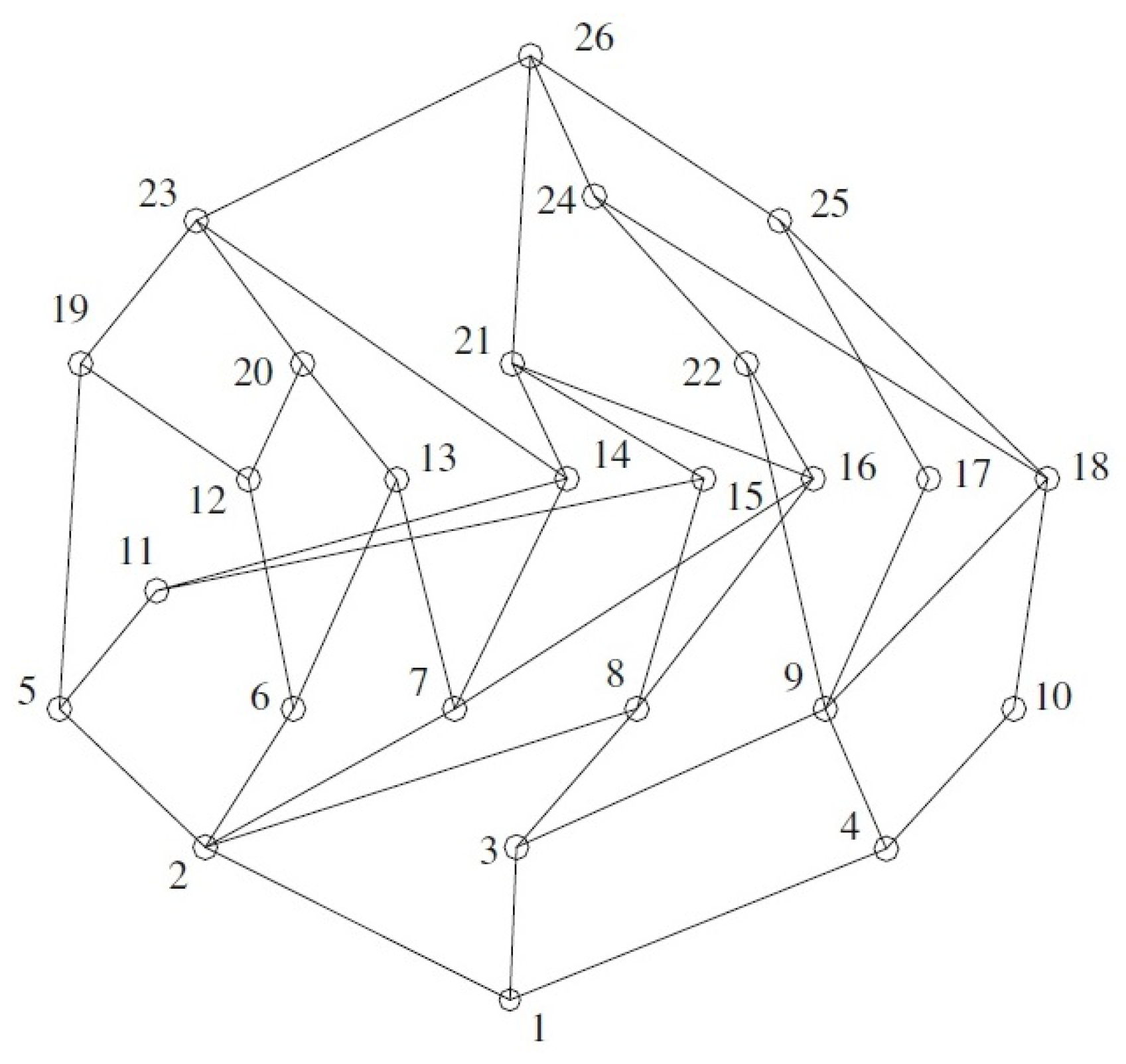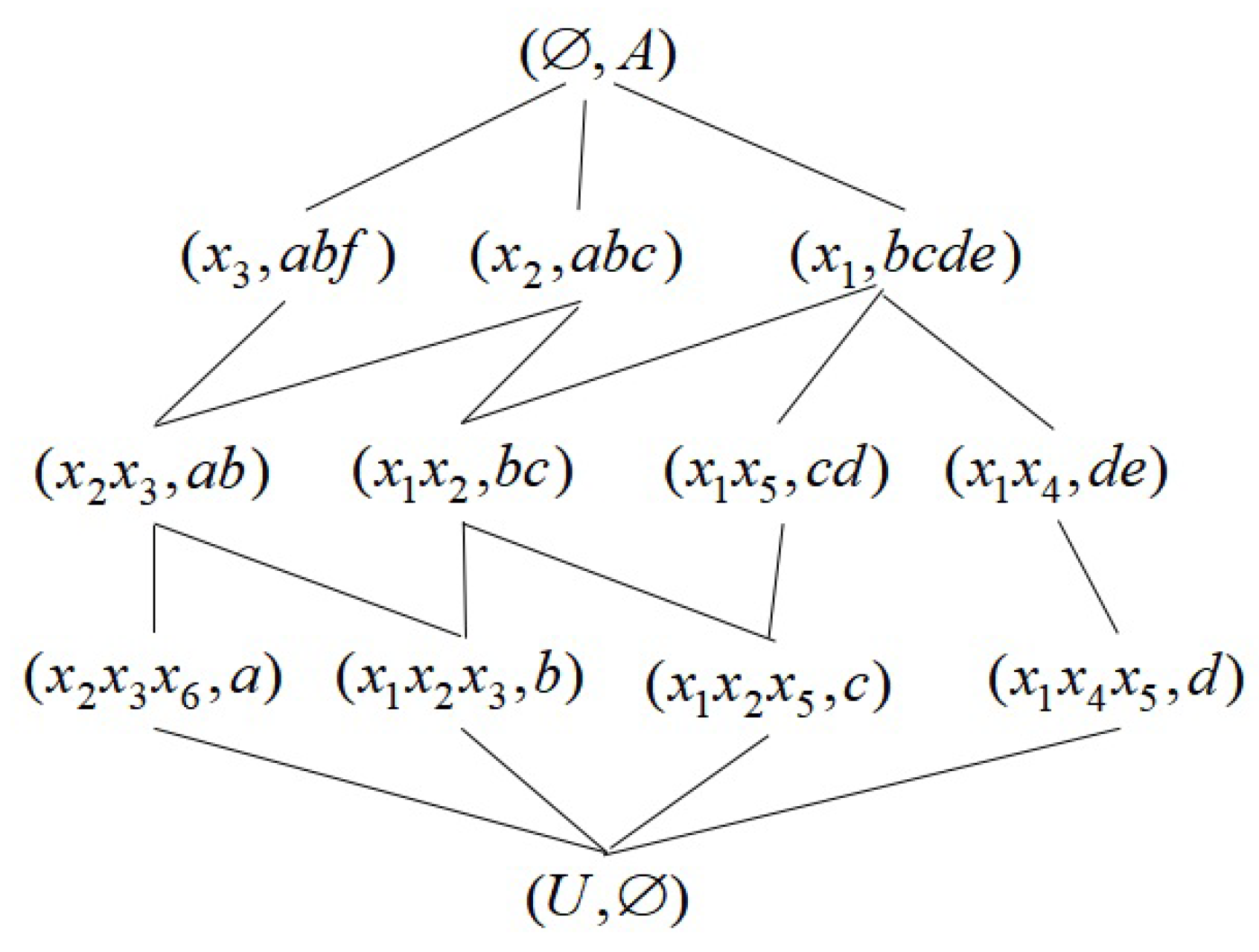A New Approach of Knowledge Reduction in Knowledge Context Based on Boolean Matrix
Abstract
1. Introduction
2. Preliminaries
2.1. Formal Concept Analysis Theory
- There exist with and ;
- There are satisfying and .
- ;
- .
2.2. Knowledge Space Theory
3. Molecular Lattice
- 1.
- .
- 2.
- .
- 1.
- , i.e., ,
- 2.
- and for with such that ,
- 1.
- , i.e., ,
- 2.
- and for with such that ,
- 1.
- For any , is an upper set, that is , there is with .
- 2.
- is an intersection–union mapping, that is suppose , then .
- 1.
- For any , is a lower set, that is, , there is with .
- 2.
- is a union-preserved mapping, that is, suppose , then .
- 1.
- and , .
- 2.
- , .
- 1.
- and , such that and ;
- 2.
- , that is, , such that .
- 1.
- ;
- 2.
- For any , there exists a minimal element in such that .
- 1.
- is called a complement-prime element if implies or .
- 2.
- is defined a join-irreducible element if implies or .
- 3.
- is seen as a prime element if implies or .
- 4.
- is called a meet-irreducible element if implies or .
- 1.
- is a complement-prime element if and only if is a join-irreducible element;
- 2.
- is a prime element if and only if is a meet-irreducible element.
4. Knowledge Reduction of Knowledge Context Based on FCA
4.1. Classification of Concepts
- ,
- ,
- ,
- ,
- ,
- ,
- .
4.2. Representing a Concept Lattice Based on a Boolean Matrix
- 1.
- if and only if for , ;
- 2.
- , ;
- 3.
- , where ;
- 4.
- , .
- 1.
- There does not exist such that , and , i.e., ;
- 2.
- and .
- 1.
- There does not exist such that , , that is, ;
- 2.
- and .
- 1.
- There exists such that and ;
- 2.
- There exist and with such that , i.e., can be represented by the union of its two sub-concepts.
| Algorithm 1: Concept reduction in formal contexts |
Input: A knowledge context , where and Output://the collection of intents of all concepts 1: Generate the relation matrix 2: Complement of object relation matrix ← 3: for ton 4: if and 5: ←, , ← // delete and in M 6: end if 7: end for 8: for ton 9: if and 10: find corresponding to 11: ←, , ← 12: end if 13: end for 14: while 15: if // empty matrix 16: 17: make uniquely so that each pair of rows in is different 18: ← 19: for tox 20: find the th, ⋯, th rows in M corresponding to 21: L ← 22: end for 23: ←, N← 24: ← 25: else 26: end if 27 end while 28: ← |
5. Conclusions
Author Contributions
Funding
Institutional Review Board Statement
Informed Consent Statement
Data Availability Statement
Conflicts of Interest
References
- Ganter, B.; Wille, R. Formal Concept Analysis; Springer: Berlin, Germany, 1999. [Google Scholar]
- Wille, R. Restructuring lattice theory: An approach based on hierarchies of concepts. In International Conference on Formal Concept Analysis; Springer: Berlin/Heidelberg, Germany, 2009; pp. 314–339. [Google Scholar]
- Wille, R. Formal concept analysis as mathematical theory of concepts and concept hierarchies. In Formal Concept Analysis; Springer: Berlin/Heidelberg, Germany, 2005; pp. 1–33. [Google Scholar]
- Belohlavek, R.; Macko, J. Selecting important concepts using weights. In International Conference on Formal Concept Analysis; Springer: Berlin/Heidelberg, Germany, 2011; pp. 65–80. [Google Scholar] [CrossRef]
- Li, J.H.; Mei, C.L.; Lv, Y.J. Knowledge reduction in formal decision contexts based on an order-preserving mapping. Int. J. Gen. Syst. 2012, 41, 143–161. [Google Scholar] [CrossRef]
- Li, J.H.; Mei, C.L.; Lv, Y.J. Incomplete decision contexts: Approximate concept construction, rule acquisition and knowledge reduction. Int. J. Approx. Reason. 2013, 54, 149–165. [Google Scholar] [CrossRef]
- Shao, M.W.; Leung, Y.; Wu, W.Z. Rule acquisition and complexity reduction in formal decision contexts. Int. J. Approx. Reason. 2014, 55, 259–274. [Google Scholar] [CrossRef]
- Li, J.L.; He, Z.Y.; Zhu, Q. An entropy-based weighted concept lattice for merging multi-source geo-ontologies. Entropy 2013, 15, 2303–2318. [Google Scholar] [CrossRef]
- Shi, Y.; Mi, Y.; Li, J.; Liu, W. Concurrent concept-cognitive learning model for classification. Inf. Sci. 2019, 496, 65–81. [Google Scholar] [CrossRef]
- Xu, W.H.; Pang, J.Z.; Luo, S.Q. A novel cognitive system model and approach to transformation of information granules. Int. J. Approx. Reason. 2014, 55, 853–866. [Google Scholar] [CrossRef]
- Kumar, C.A.; Ishwarya, M.S.; Loo, C.K. Formal concept analysis approach to cognitive functionalities of bidirectional associative memory. Biol. Inspired Cogn. Archit. 2015, 12, 20–33. [Google Scholar]
- Li, J.; Mei, C.; Xu, W.; Qian, Y. Concept learning via granular computing: A cognitive viewpoint. Inf. Sci. 2015, 298, 447–467. [Google Scholar] [CrossRef]
- Zhi, H.L.; Li, J.H. Granule description based on formal concept analysis. Knowl. Based Syst. 2016, 104, 62–73. [Google Scholar] [CrossRef]
- Fan, B.; Tsang, E.C.; Xu, W.; Chen, D.; Li, W. Attribute-oriented cognitive concept learning strategy: A multi-level method. Int. J. Mach. Learn. Cybern. 2019, 10, 2421–2437. [Google Scholar] [CrossRef]
- Berry, A.; Sigayret, A. Representing a concept lattice by a graph. Discret. Appl. Math. 2004, 144, 27–42. [Google Scholar] [CrossRef][Green Version]
- Kuznetsov, S.; Obiedkov, S. Comparing performance of algorithms for generating concept lattices. J. Exp. Theor. Artif. Intell. 2002, 14, 189–216. [Google Scholar] [CrossRef]
- Kumar, C.A.; Srinivas, S. Concept lattice reduction using fuzzy K-means clustering. Expert Syst. Appl. 2010, 37, 2696–2704. [Google Scholar] [CrossRef]
- Kardoš, F.; Pócs, J.; Pócsová, J. On concept reduction based on some graph properties. Knowl. Based Syst. 2016, 93, 67–74. [Google Scholar] [CrossRef]
- Dias, S.M.; Vieira, N.J. Concept lattices reduction: Definition, analysis and classification. Expert Syst. Appl. 2015, 42, 7084–7097. [Google Scholar] [CrossRef]
- Singh, P.K.; Gani, A. Fuzzy concept lattice reduction using Shannon entropy and Huffman coding. J. Appl. Non-Class. Log. 2015, 25, 101–119. [Google Scholar] [CrossRef]
- Dias, S.M.; Vieira, N.J. A methodology for analysis of concept lattice reduction. Inf. Sci. 2017, 396, 202–217. [Google Scholar] [CrossRef]
- Wu, W.; Leung, Y.; Mi, J. Granular computing and knowledge reduction in formal contexts. IEEE Trans. Knowl. Data Eng. 2009, 21, 1461–1474. [Google Scholar]
- Kumar, A.C.; Dias, S.M.; Vieira, N. Knowledge reduction in formal contexts using non-negative matrix factorization. Math. Comput. Simul. 2015, 109, 46–63. [Google Scholar]
- Li, J.H.; Mei, C.L.; Lv, Y.J. A heuristic knowledge-reduction method for decision formal contexts. Comput. Math. Appl. 2011, 61, 1096–1106. [Google Scholar] [CrossRef]
- Li, J.H.; Mei, C.L.; Lv, Y.J. Knowledge reduction in real decision formal contexts. Inf. Sci. 2012, 189, 191–207. [Google Scholar] [CrossRef]
- Li, J.H.; Mei, C.L.; Kumar, C.A.; Zhang, X. On rule acquisition in decision formal contexts. Int. J. Mach. Learn. Cybern. 2013, 4, 721–731. [Google Scholar] [CrossRef]
- Benítez-Caballero, M.J.; Medina, J.; Ramírez-Poussa, E. Attribute reduction in rough set theory and formal concept analysis. In International Joint Conference on Rough Sets; Springer: Cham, Switzerland, 2017; pp. 513–525. [Google Scholar]
- Chen, J.K.; Mi, J.S.; Lin, Y.J. A graph approach for knowledge reduction in formal contexts. Knowl. Based Syst. 2018, 148, 177–188. [Google Scholar] [CrossRef]
- Shi, L.L.; Yang, H.L. Object granular reduction of fuzzy formal contexts. J. Intell. Fuzzy Syst. 2018, 34, 633–644. [Google Scholar] [CrossRef]
- Doignon, J.P.; Falmagne, J.C. Spaces for the assessment of knowledge. Int. J. Man-Mach. Stud. 1985, 23, 175–196. [Google Scholar] [CrossRef]
- Doignon, J.P.; Falmagne, J.C. Knowledge Spaces; Springer Science & Business Media: Berlin/Heidelberg, Germany, 2012. [Google Scholar]
- Falmagne, J.C.; Doignon, J.P. Learning Spaces: Interdisciplinary Applied Mathematics; Springer Science & Business Media: Berlin/Heidelberg, Germany, 2010. [Google Scholar]
- Falmagne, J.C.; Koppen, M.; Villano, M.; Doignon, J.P.; Johannesen, L. Introduction to knowledge spaces: How to build, test, and search them. Psychol. Rev. 1990, 97, 201–224. [Google Scholar] [CrossRef]
- Rusch, A.; Wille, R. Knowledge Spaces and Formal Concept Analysis. Data Analysis and Information Systems; Springer: Berlin/Heidelberg, Germany, 1996; pp. 427–436. [Google Scholar]
- Koppen, M.; Doignon, J.P. How to build a knowledge space by querying an expert. J. Math. Psychol. 1990, 34, 311–331. [Google Scholar] [CrossRef]
- Koppen, M. Extracting human expertise for constructing knowledge spaces: An algorithm. J. Math. Psychol. 1993, 37, 1–20. [Google Scholar] [CrossRef]
- Kambouri, M.; Koppen, M.; Villano, M.; Falmagne, J.C. Knowledge assessment: Tapping human expertise by the QUERY routine. Int. J. Hum. Comput. Stud. 1994, 40, 119–151. [Google Scholar] [CrossRef]
- Klimushkin, M.; Obiedkov, S.; Roth, C. Approaches to the Selection of Relevant Concepts in the Case of Noisy Data. International Conference on Formal Concept Analysis; Springer: Berlin/Heidelberg, Germany, 2010; pp. 255–266. [Google Scholar]
- Sambin, G.; Valentini, S. Topological characterization of Scott domains. Arch. Math. Log. 2005, 66, 13–21. [Google Scholar]
- Lipschutz, S. Schaum’s Outline of Theory and Problems of General Topology; Schaum Pub. Co.: Ogden, UT, USA, 1965. [Google Scholar]
- Caspard, N.; Monjardet, B. The lattices of closure systems, closure operators, and implicational systems on a finite set: A survey. Discret. Appl. Math. 2003, 127, 241–269. [Google Scholar] [CrossRef]
- Davey, B.A.; Priestley, H.A. Introduction to Lattices and Order; Cambridge University Press: Cambridge, UK, 2002. [Google Scholar]
- Zhang, Q.X. The judgment method of consistent sets in decision formal context based on Boolean matrix. J. Zhangzhou Norm. Univ. 2012, 25, 22–25. [Google Scholar]
- Mao, H.; Yang, L.; Dou, L.L. An algorithm of generating concept lattice utilizing row rank of matrix. Coll. Math. 2010, 115–117. [Google Scholar]


| p | q | r | s | |
|---|---|---|---|---|
| 0 | 0 | 1 | 1 | |
| 1 | 0 | 1 | 1 | |
| 0 | 1 | 0 | 0 | |
| 1 | 1 | 1 | 1 | |
| 1 | 1 | 1 | 0 |
| I | a | b | c | d | e | f |
|---|---|---|---|---|---|---|
| 0 | 1 | 1 | 1 | 1 | 0 | |
| 1 | 1 | 1 | 0 | 0 | 0 | |
| 1 | 1 | 0 | 0 | 0 | 1 | |
| 0 | 0 | 0 | 1 | 1 | 0 | |
| 0 | 0 | 1 | 1 | 0 | 0 | |
| 1 | 0 | 0 | 0 | 0 | 0 |
Publisher’s Note: MDPI stays neutral with regard to jurisdictional claims in published maps and institutional affiliations. |
© 2022 by the authors. Licensee MDPI, Basel, Switzerland. This article is an open access article distributed under the terms and conditions of the Creative Commons Attribution (CC BY) license (https://creativecommons.org/licenses/by/4.0/).
Share and Cite
Yang, L.; Li, J.; Zhang, C.; Lin, Y. A New Approach of Knowledge Reduction in Knowledge Context Based on Boolean Matrix. Symmetry 2022, 14, 850. https://doi.org/10.3390/sym14050850
Yang L, Li J, Zhang C, Lin Y. A New Approach of Knowledge Reduction in Knowledge Context Based on Boolean Matrix. Symmetry. 2022; 14(5):850. https://doi.org/10.3390/sym14050850
Chicago/Turabian StyleYang, Liying, Jinjin Li, Chengling Zhang, and Yidong Lin. 2022. "A New Approach of Knowledge Reduction in Knowledge Context Based on Boolean Matrix" Symmetry 14, no. 5: 850. https://doi.org/10.3390/sym14050850
APA StyleYang, L., Li, J., Zhang, C., & Lin, Y. (2022). A New Approach of Knowledge Reduction in Knowledge Context Based on Boolean Matrix. Symmetry, 14(5), 850. https://doi.org/10.3390/sym14050850





